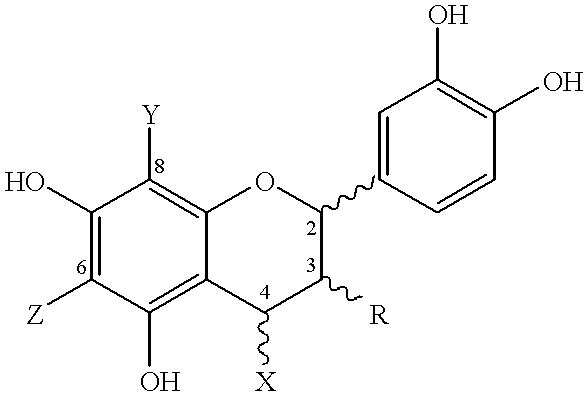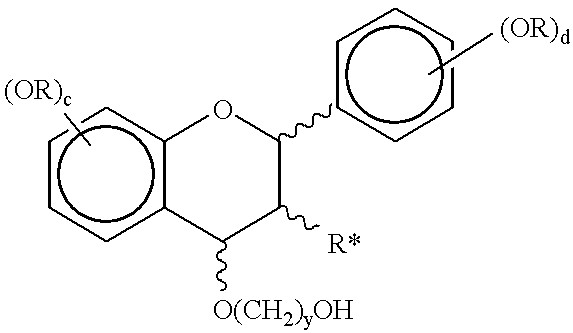Process for preparing procyanidin(4-6 or 4-8) oligomers and their derivatives
a technology of procyanidin and oligomer, which is applied in the field of synthesizing polyphenols and derivatives, can solve the problems of increasing the size of oligomers, increasing the complexity of structural components, and reducing the efficiency of current analytical methods of separation, and achieves the effect of facilitating the determination of how polyphenol compounds are formed
- Summary
- Abstract
- Description
- Claims
- Application Information
AI Technical Summary
Benefits of technology
Problems solved by technology
Method used
Image
Examples
example 2
Preparation of (2R)-5,7,3',4' Tetrakis(benzyloxy)flavan-3-one
Freshly prepared Dess-Martin periodinane (39.0 g, 92 mmol, prepared by the method of D. B. Dess and J. C. Martin, J. Am. Chem. Soc. 113, 7277-7287 (1991) and R. E. Ireland and L. Liu, J. Org. Chem. 58, 2899 (1993)), was added at room temperature, all at once, to a stirred solution of the tetra-O-benzyl catechin according to Example 1 (54.4 g, 83.8 mmol) in methylene chloride (420 mL). Within 1.5 h, approx. 30 mL of water-saturated methylene chloride was added dropwise to the reaction mixture to form a turbid amber-colored solution. (S. D. Meyer and S. L. Schreiber, J. Org. Chem., 59, 7549-7552 (1994)) Twenty minutes thereafter, the reaction mixture was diluted with a saturated solution of NaHCO.sub.3 (500 mL) and a 10% aqueous solution of Na.sub.2 S.sub.2 O.sub.5.5H.sub.2 O (200 mL). The phases were separated and the aqueous phase extracted with 50 mL of methylene chloride. The combined organic phases were filtered over si...
example 3
Preparation of 5,7,3',4'-Tetra-O-benzylepicatechin
A 1 M solution of lithium tri-sec-butylborohydride in tetrahydrofuran, herein after THF, (100 mL, L-Selectride.RTM., sold by the Aldrich Chemical Co, Inc., Milwaukee, Wis.) was added, under an argon atmosphere, to a stirred, 0.degree. C. solution of anhydrous LiBr (34.9 g, 402 mmol) in 100 mL anhydrous THF. The resulting mixture was cooled to -78.degree. C., using an acetone / CO.sub.2 bath, followed by dropwise addition of a solution of the flavanone according to Example 2 (50.1 g, 77.2 mmol) in 400 mL of anhydrous THF, over a period of 50 min. Stirring was continued at -78.degree. C. for 135 min. The cooling bath was removed and 360 mL of 2.5 M aqueous NaOH was added to the reaction mixture. The reaction flask was placed in a room temperature water bath and a mixture of 35% aqueous H.sub.2 O.sub.2 (90 mL) and ethanol (270 mL) was added over a period of 130 min. Stirring was continued overnight. Chloroform (700 mL) was added to dissol...
example 4
Preparation of (2R,3S,4S)-5,7,3',4'-Tetra-O-benzyl-4-(2-hydroxyethoxy)epicatechin
Ethylene glycol (6.4 mL, 115 mmol, 5.8 eq.) was added, at room temperature, with stirring, to a solution of the tetra-O-benzylepicatechin according to Example 3 (12.75 g, 19.6 mmol) in 130 mL of anhydrous methylene chloride, followed by addition of 2,3-dichloro-5,6-dicyano-1,4-benzoquinone (DDQ, 8.9 g, 39.2 mmol, 2.0 eq.), at one time, with vigorous stirring. (J. A. Steenkamp, et al., Tetrahedron Letters, 26, (25) 3045-3048 (1985)). After approximately 2 hours, 4-dimethylaminopyridine (DMAP, 4.8 g, 39.2 mmol) was added to the reaction mixture, resulting in the formation of a dark green precipitate. After stirring for an additional 5 minutes, 100 g of silica gel was added, and the mixture was concentrated under reduced pressure. The residue was placed on top of a silica gel column (11.times.6.5 cm) which was eluted with EtOAc / hexane (1:1), and the eluate was concentrated under reduced pressure. The resul...
PUM
| Property | Measurement | Unit |
|---|---|---|
| Pressure | aaaaa | aaaaa |
Abstract
Description
Claims
Application Information
 Login to View More
Login to View More - R&D
- Intellectual Property
- Life Sciences
- Materials
- Tech Scout
- Unparalleled Data Quality
- Higher Quality Content
- 60% Fewer Hallucinations
Browse by: Latest US Patents, China's latest patents, Technical Efficacy Thesaurus, Application Domain, Technology Topic, Popular Technical Reports.
© 2025 PatSnap. All rights reserved.Legal|Privacy policy|Modern Slavery Act Transparency Statement|Sitemap|About US| Contact US: help@patsnap.com



